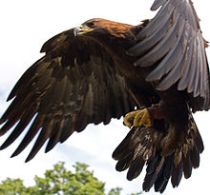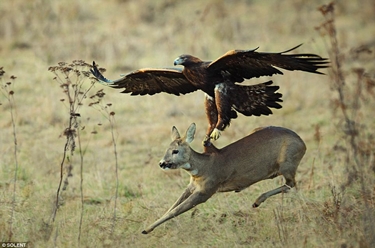In Scotland, a new offence of Vicarious Liability came into force in January 2012. It is designed to deal with landowners and managers who turn a blind eye to employees committing offences against wild birds on their land.
Thanks to the new wildlife crime legislation targeting landowners, poisoning incidents fell from 10, involving 16 birds, in 2011 to three in 2012, according to the latest figures. But the RSPB warned that there were still concerns birds could be killed using other methods that are more difficult to detect.
The latest figures, released by the Partnership for Action Against Wildlife Crime (Paw) Scotland, showed that two buzzards and a golden eagle died through poisoning during the first year of the new legislation being in force.
One victim of poison is the Golden Eagle – the most common national animal in the world, with five nations—Albania, Germany, Austria, Mexico and Kazakhstan—making it the national animal. It is also a common motif in the national symbols of countries that have not officially made it the national animal or national bird.
Albania
Egypt
Mexico
Among European countries, the Golden Eagle was the model for the aquila, the most prominent symbol of the Roman legions and more generally the Roman civilization that had such a powerful impact on Western culture;
Eagle of Roman Empire
This association of the Golden Eagle with Rome has also led to the adoption of similar symbols in other countries; for instance, the adoption of the related and physically similar Bald Eagle as the national bird of the United States was inspired by the conception of the United States as a modern reincarnation of the Roman Republic, a theme that recurs in other elements as well (including the prevalence of neoclassical architecture in American public buildings and the use of Roman terminology—such as naming the upper house of Congress.
Great Seal of the United States
The Golden Eagle uses its agility and speed combined with extremely powerful talons to snatch up a variety of prey, including rabbits, marmots, ground squirrels, and large mammals such as foxes and young ungulates.[4] They will also eat carrion if live prey is scarce, as well as reptiles. Birds, including large species up to the size of swans and cranes have also been recorded as prey.
For centuries, this species has been one of the most highly regarded birds used in falconry, with the Eurasian subspecies having been used to hunt and kill unnatural, dangerous prey such as Gray Wolves (Canis lupus) in some native communities. Due to their hunting prowess, the Golden Eagle is regarded with great mystic reverence in some ancient, tribal cultures.
Facts:
Golden Eagles can grow to 33 to 38 in (84 to 97 cm) with a wingspan of 6 to 7.5 ft (1.8 to 2.3 m) and weigh6 to 15 lbs (3 to 7 kg.) They maintain territories that may be as large as 155 km2 (60 sq mi) and are monogamous. Pairs may remain together for several years or possibly for life. Golden Eagles nest in high places including cliffs, trees, or human structures such as telephone poles. They build huge nests to which they may return for several breeding years. Females lay from one to four eggs, and both parents incubate them for 40 to 45 days. Typically, one or two young survive to fledge in about three months. Their average life span in the wild
Hopefully, the Golden Eagle will be as respected as it was in the past.
_____________________________________________________________________________
Something light to read:
Secrets And Sinners
https://www.smashwords.com/books/view/372788
The adventures of Elfis






